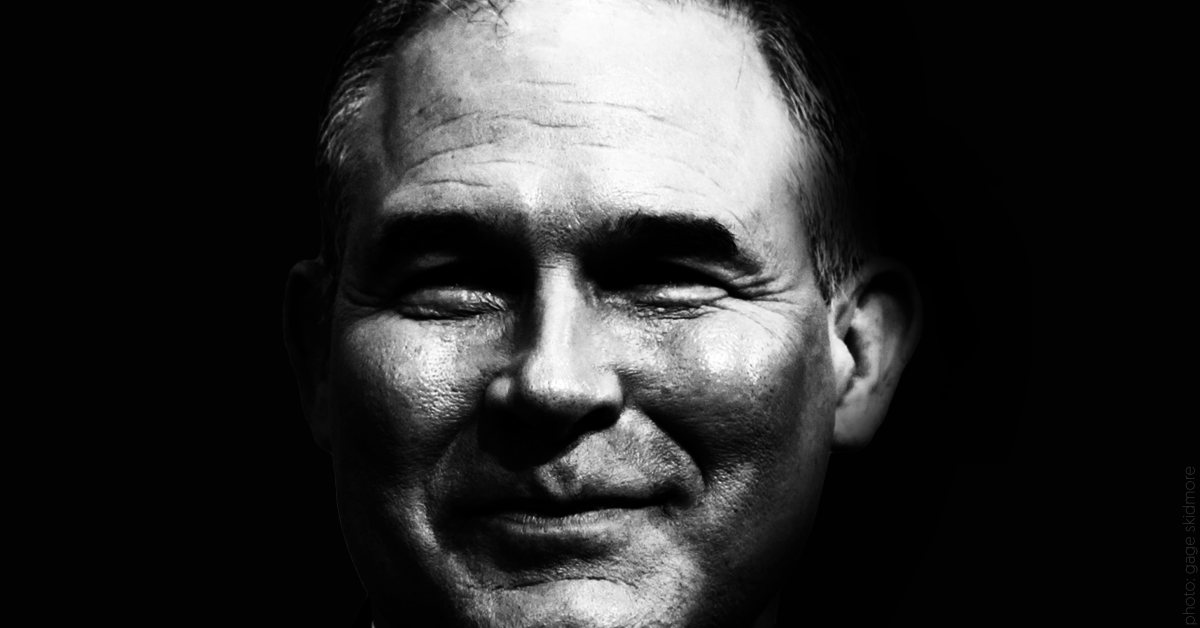
Sarah Wasko / Media Matters
This post was updated on 5/23/18 to incorporate additional news reports.
Reporters from The Associated Press, CNN, E&E News, and Politico were barred from attending parts of an Environmental Protection Agency summit on water contaminants on May 22 and 23. At one point, security guards used force to remove an AP reporter from the building.
From a May 22 AP report:
The Environmental Protection Agency is barring The Associated Press, CNN and the environmental-focused news organization E&E from a national summit on harmful water contaminants.
The EPA blocked the news organizations from attending Tuesday’s Washington meeting, convened by EPA chief Scott Pruitt.
EPA spokesman Jahan Wilcox told the barred organizations they were not invited and there was no space for them, but gave no indication of why they specifically were barred.
Pruitt told about 200 people at the meeting that dealing with the contaminants is a “national priority.”
The AP’s environmental reporter tweeted about the incident:
The @AP, @CNN and E&E all showed up to cover this @EPA meeting on widespread, dangerous contaminants in many drinking water systems around the country. We were all turned away at the door of the EPA building. https://t.co/j8JthyiM3k
— Ellen Knickmeyer (@KnickmeyerEllen) May 22, 2018
The @EPA told @AP, @CNN they weren't invited to @AdministratorPruitt's #PFAS summit. EPA guards grabbed AP reporter by shoulders, shoved reporter out of building when she asked to talk to agency public-affairs person about covering meeting https://t.co/9g1BZsG8cy
— Ellen Knickmeyer (@KnickmeyerEllen) May 22, 2018
An E&E News reporter tweeted:
This morning's PFAS Leadership Summit at @EPA headquarters is open to the press... just not to reporters from @EENewsUpdates, @AP or @CNN. We've all asked the agency's press office why we're being selectively shut out and have gotten no responses.
— Corbin Hiar (@CorbinHiar) May 22, 2018
Hallie Jackson of NBC News relayed an EPA spokesperson's response:
EPA spox tells me the reporter “was not invited” and threatened negative coverage if she wasn’t allowed in. “We provided a livestream.” When asked how that excuses physically grabbing a reporter, he indicated he wasn’t involved in that and would get back to me. https://t.co/goUIVs19Xd
— Hallie Jackson (@HallieJackson) May 22, 2018
CNN issued a statement:
CNN has issued a statement on getting turned away from the EPA summit today. pic.twitter.com/BAnekREfIr
— ErikWemple (@ErikWemple) May 22, 2018
The EPA issued a statement opening the second half of the May 22 meeting to any outlet, contradicting a previous statement:
This is a total 180 from the statement EPA gave earlier that space restraints limited attendance.
Now appears any outlet who wants to attend the second half of the hearing can. (It was previously opened to no press) https://t.co/Vwp8RRhCqQ— Miranda Green (@mirandacgreen) May 22, 2018
But on the following day, May 23, the EPA again blocked journalists from attending the summit, including Emily Holden from Politico, author and journalist Mariah Blake, and, once again, journalists from E&E News and CNN.
I’m standing at EPA’s chemicals summit, where I’m told by security that I can’t enter and can’t stand inside because it is invite only and no press. They were polite but refused to call public affairs staff, even if I gave them the number (which they said they didn’t have).
— Emily Holden (@emilyhholden) May 23, 2018
Others blocked today include @corbinhiar and @MariahCBlake. Am I missing anyone else who tried? https://t.co/O6wEZuYrOG
— Emily Holden (@emilyhholden) May 23, 2018
I'm told CNN's producer was also turned away from EPA's toxic chemicals summit. That makes at least four of us.
— Emily Holden (@emilyhholden) May 23, 2018
As Holden reported, “The Federal Advisory Committee Act states that ‘any committee, board, commission, council, conference, panel, task force, or other similar group’ used by an agency ‘in the interest of obtaining advice or recommendations’ for the federal government must be open to the public.” Holden asked for a statement about why the EPA thinks its actions were not a violation of the act, but the EPA simply pointed her to its statement from the previous day about the event being at capacity.
This is just the latest in a long string of incidents in which EPA Administrator Scott Pruitt's press team has blocked reporters from events as well as dropped them from press release distribution lists and retaliated against them in other ways. On April 3, Pruitt barred reporters from his announcement about loosening automobile fuel economy standards. Journalists have been escorted out of Pruitt events by police. Reporters from The Associated Press and The New York Times have been personally attacked in official agency press releases. And the EPA has repeatedly refused to give reporters basic information about the agency's staffing and activities.
Pruitt is currently under fire for multiple scandals and seemingly corrupt activities, including a sweetheart deal he got to rent a D.C. condo from the wife of an energy lobbyist.
The Trump administration has a history of blacklisting reporters. In February of 2017, reporters from The New York Times, CNN, the Los Angeles Times, BuzzFeed News, and Politico were barred from attending a briefing in then-press secretary Sean Spicer’s office. During the campaign, Trump banned a number of outlets from his events. There are numerous other examples of Trump’s war on the press.
The May 22 and 23 summit on per- and polyfluoroalkyl substances (PFAS) comes days after a Politico report revealed that Pruitt’s EPA and the White House sought to block a Health and Human Services study about PFAS and water contamination that “would show that the chemicals endanger human health at a far lower level than EPA has previously called safe.” According to the article, a Trump aide had said the release of the study would cause a “public relations nightmare.”